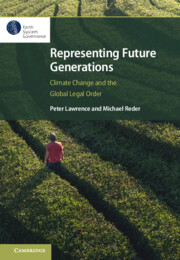Book contents
- Representing Future Generations
- Series page
- Representing Future Generations
- Copyright page
- Contents
- Preface
- 1 Introduction
- Part I Normative Framework
- Part II International Law and Institutions
- 4 Criteria for Evaluating Mechanisms for Representation of Future Generations
- 5 Lessons from Existing International Institutions to Represent Vulnerable Groups
- Part III Case Studies
- Index
- References
5 - Lessons from Existing International Institutions to Represent Vulnerable Groups
from Part II - International Law and Institutions
Published online by Cambridge University Press: 19 September 2025
- Representing Future Generations
- Series page
- Representing Future Generations
- Copyright page
- Contents
- Preface
- 1 Introduction
- Part I Normative Framework
- Part II International Law and Institutions
- 4 Criteria for Evaluating Mechanisms for Representation of Future Generations
- 5 Lessons from Existing International Institutions to Represent Vulnerable Groups
- Part III Case Studies
- Index
- References
Summary
Chapter 5 traces the history of a number of existing UN mechanisms which represent the interests of particular vulnerable groups in the international system (persons with disabilities, women, and children). The aim of this analysis is to see what types of normative discourses have found traction and led to the development of institutions to represent these vulnerable groups, in order to ascertain the type of normative arguments that would gain support in arguing for international institutions to represent future generations. An important lesson from the case studies is that a normative discourse in which development concerns feature prominently, has been a common thread running through the history of these UN mechanisms. The chapter analyses the differences and similarities between arguments which justify the institutions which have been put in place to represent these vulnerable groups, with arguments used to justify institutions to represent future generations.
Keywords
Information
- Type
- Chapter
- Information
- Representing Future GenerationsClimate Change and the Global Legal Order, pp. 116 - 142Publisher: Cambridge University PressPrint publication year: 2025
